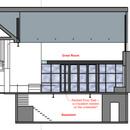Radiant floor over a basement
Hi,
I’m designing an addition to an existing home outside of Philadelphia which will feature a 1000sqft great room with cathedral ceilings (27’ at ridge). The floor will be a concrete slab with radiant heat and there will be a new basement below it (which will be fully insulated.)
My question is, does the floor slab need to be insulated from below? I don’t think it does but my contractor disagrees. My opinion is that the heat dynamics are such that most of the heat will rise into the great room space and whatever heat radiates into the basement will be an added bonus. But my contractor wants to insulate the underside of the floor slab to prevent over-heating in the basement. I don’t think this is necessary and I’d like to avoid that added cost, but I am having trouble finding any resources to answer this debate.
I have attached an image for clarity.
Any help and advice would be greatly appreciated.
Thank you!
GBA Detail Library
A collection of one thousand construction details organized by climate and house part










Replies
Heat radiates just fine in all directions.
The heat loss characteristics of basements are very different from and lower than above-grade rooms, and EXTREMELY different from very tall rooms.
If you don't insulate the basement ceiling you'll most likely overheat the basement (by a lot) whenever it's cold outside due to an excessively warm radiant ceiling far in excess of the basement's own heat load. With the calculated heat loss numbers on the great room and the room below it, and the amount of radiant floor area it would be possible to estimate the amount of overheating, but does it matter? An 80F+ basement when it's 70F upstairs, 20F outdoors isn't really a "bonus", nor is a 75F basement under those conditions.
Over a fully conditioned heated basement R11-R13 batts snugged up to the subfloor would be enough zone isolation to prevent the overheating. If the basement isn't normally going to be heated and you'd like it to run on the cool side for lower overall heat loss cheap R19s snugged up to the subfloor would be called for.
Thank you Dana, really appreciate your considered thoughts.
Say the slab never exceeds 75F. It certainly won't heat the basement to 75+F and due to the fact that warm air rises, it will contribute less heat to the basement than you might think.
On the other hand, basement and above ground room loads aren't well correlated and whatever the up/down heat flow ratio is, it won't be exactly what you want under all conditions.
It's possible that mild overheating (say sometimes 74F when you want 70F) is worth the cost savings to you.
It's unlikely that the load of the very tall room above would call for peak floor temps as low as 75F. But without any of the load numbers it's really impossible to say. The radiant floor zone in a 2x6 framed addition with much lower ceilings than the 20'+ room described the floor temps hit 75F to keep up when it's 25F outside. (Too much window, and rugs/furniture impeding heat flow under half the floor area.) Even with R19s between the joists under the floor the insulated basement room below stays in the mid to high 60s during colder weather.
The primary heat transfer from a radiant ceiling is from radiation, not convection. Even with radiant floors the convection component isn't super-dominant. Low temp heating just isn't that big a convection driver, so the "...warm air rises..." doesn't much matter.
Also, 1000 square feet of R11-R13 batts to guarantee zone isolation doesn't really cost very much. You're probably talking $300-500 of cost adder.